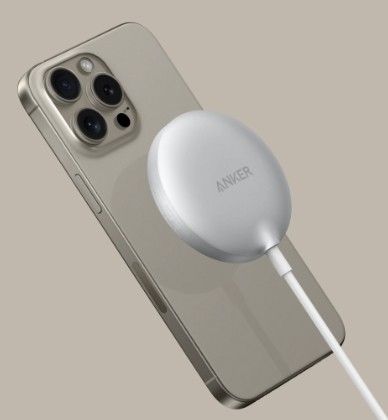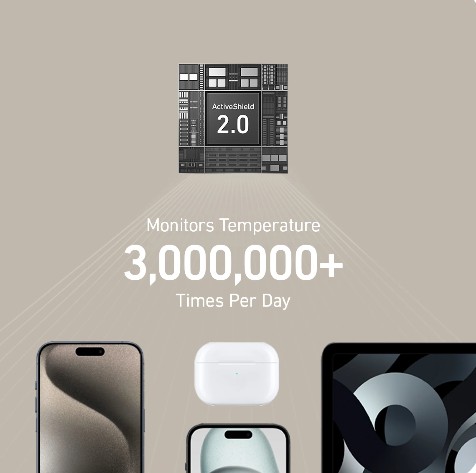Because it is more convenient and easier to use, wireless charging has swiftly replaced older cable charging methods. You may charge your cellphone wirelessly from a charging pad using electromagnetic induction, eliminating the need for cords. But worries about the effect on battery life have arisen as its use grows. Does wireless charging really work as well as it claims to, or are there any dangers that might shorten the life of your device? Discover the ins and outs of wireless charging, if it's bad for your battery, and how to keep your gadget safe in this blog post.

Does Wireless Charging Harm Your Battery Health?
Many worry that wireless charging would damage their device's battery, although it doesn't always. Charging batteries wirelessly does not drain them. Certified products like the Anker MagGo Wireless Charger (Pad) allow safe usage. The main concern is overheating, which may limit a battery's life. Elite chargers like the Anker MagGo provide advanced safety features like ActiveShield, which monitors the charger's temperature up to three million times a day. This keeps your gadget safe and cool while charging, extending battery life.
How Wireless Charging Works
Electromagnetic induction is the mechanism by which energy is transmitted from the charger to the device while utilizing wireless charging. Coils built between the smartphone and the charging pad produce a magnetic field that transmits energy to the phone's battery. This procedure may be made easy with Qi-certified chargers like the Anker MagGo Wireless Charger (Pad). These chargers have powerful magnets for accurate alignment and speedy snap-to-charge capabilities. Many people prefer this technique since it lowers wear and tear on charging ports and gets rid of the trouble of plugging in wires.
Impact on Battery Longevity
There is no correlation between wireless charging and shorter battery life. Heat and charging frequency are the two primary variables that determine battery life. Contemporary chargers, such as the Anker MagGo, include features that reduce the battery's degradation caused by prolonged exposure to high temperatures. The battery's ideal temperature is maintained by features including enhanced heat dissipation using aluminum alloy components, which helps to preserve its longevity. If done properly, wireless charging is just as safe for your battery as cable charging in terms of preventing overheating.
Comparison with Wired Charging
Wireless charging is catching up to wired charging, thanks to breakthroughs like Wireless PowerIQTM technology from Anker. With a maximum output of 15W, the Anker MagGo Wireless Charger (Pad) can charge most smartphones—including the newest iPhones—at a rate comparable to that of cable charging. Furthermore, compared to conventional alternatives, wireless charging is more convenient. With magnetic alignments, such as what the MagGo offers, you can charge your smartphone conveniently without tripping over cords or worrying about ruining the charging port.

What Are the Benefits and Drawbacks of Wireless Charging?
Convenience and Ease of Use
The ease of use is a major plus for wireless charging. You won't have to worry about frayed cords or broken charging ports anymore when you use a charging pad. In addition to being very convenient, the Anker MagGo Wireless Charger's powerful built-in magnets guarantee precise alignment for rapid and efficient charging. Thanks to this frictionless experience, customers can charge their gadgets without continually fiddling with wires. You can charge your smartphone anywhere thanks to the 5-foot extendable cord, which gives you even more freedom.
Overheating Concerns
When charging, whether wirelessly or with cords, there is a danger of overheating, which might eventually damage the battery's health. Although certain wireless chargers, such as the Anker MagGo, produce heat during energy transmission, these devices have built-in protections to prevent overheating. In order to keep the charger's temperature from becoming too high, the ActiveShield system keeps a constant eye on it. A steady and constant charging process is further assured by the charger's usage of aluminum alloy, which helps dissipate heat more efficiently. With these improvements, wireless charging is now safer, and overheating is less likely to happen.
Charging Speed Differences
Although cable charging has always been faster, technological advancements have made wireless charging much faster. For instance, the Anker MagGo Wireless Charger (Pad) 's 15W charging speed is made possible by its Qi2 certification and Wireless PowerIQTM technology, which adjusts power output intelligently for best performance. What this implies is that the charging speed is almost identical to that of a standard wire. Having said that, cable charging does provide a modest performance advantage for some high-demand tasks, such as quick charging while gaming. However, the speed difference is hardly imperceptible for everyday usage.
How Can You Protect Your Battery While Using Wireless Charging?
Use Official or Certified Chargers
Only use approved or authorized wireless chargers, including those with Qi2 certification, to keep your device's battery safe and extend its lifespan. One approved charger that satisfies rigorous safety criteria is the Anker MagGo Wireless Charger. Certified chargers prevent overheating, overcharging, and irregular energy transfer while delivering the best possible power delivery. Because of their shoddy construction or absence of safety measures, using chargers that have not been approved might endanger your battery. If you want your battery to be safe and charge quickly every time, use a reputable brand like Anker.
Avoid Wireless Charging Overnight
Leaving your gadget plugged into the charger all night long may be handy, but it may shorten the life of your battery due to the continuous exposure to heat. It is still recommended not to charge overnight, even with safety measures such as the Anker MagGo's continuous temperature monitoring. The wireless charging pad will keep providing a steady stream of modest quantities of electricity until your smartphone is fully charged. An excess of heat may be produced by this. Avoid keeping your gadget plugged in for lengthy periods of time to keep the battery healthy. Instead, try charging it in small spurts throughout the day.
Charge in a Cool Environment
One of the main factors that shorten the life of a battery is heat. The battery life of your phone may be extended by keeping it in a cool place while it is being charged, regardless of whether you are using a wired or wireless approach. Your smartphone will stay cool while it charges with the Anker MagGo Wireless Charger because of its design, which makes use of aluminum alloy components to enhance heat dissipation. Still, the phone may become too hot from things beyond its control, such as a stuffy environment or strong sunshine. Charging in a cool, well-ventilated place will safeguard the battery and maximize your device's charging efficiency.
Conclusion
Wireless charging is safe and easy with current chargers like the Anker MagGo Wireless Charger (Pad). Quick and efficient charging (15W) with Qi2 certified and ActiveShield protects your smartphone. Even if battery health concerns persist, charging in a cool environment, not overnight, and using authorized chargers may extend battery life. Wireless charging is better than wired charging because it lets users use their devices without cords and maintains them in good condition.
